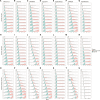Addressing the mean-variance relationship in spatially resolved transcriptomics data with spoon
- PMID: 40515599
- PMCID: PMC12166475
- DOI: 10.1093/biostatistics/kxaf012
Addressing the mean-variance relationship in spatially resolved transcriptomics data with spoon
Abstract
An important task in the analysis of spatially resolved transcriptomics (SRT) data is to identify spatially variable genes (SVGs), or genes that vary in a 2D space. Current approaches rank SVGs based on either $ P $-values or an effect size, such as the proportion of spatial variance. However, previous work in the analysis of RNA-sequencing data identified a technical bias with log-transformation, violating the "mean-variance relationship" of gene counts, where highly expressed genes are more likely to have a higher variance in counts but lower variance after log-transformation. Here, we demonstrate the mean-variance relationship in SRT data. Furthermore, we propose spoon, a statistical framework using empirical Bayes techniques to remove this bias, leading to more accurate prioritization of SVGs. We demonstrate the performance of spoon in both simulated and real SRT data. A software implementation of our method is available at https://bioconductor.org/packages/spoon.
Keywords: Gaussian process regression; empirical Bayes; mean–variance bias; spatial transcriptomics; spatially variable gene.
© The Author 2025. Published by Oxford University Press.
Conflict of interest statement
No competing interest is declared.
Figures





Update of
-
Addressing the mean-variance relationship in spatially resolved transcriptomics data with spoon.bioRxiv [Preprint]. 2024 Nov 8:2024.11.04.621867. doi: 10.1101/2024.11.04.621867. bioRxiv. 2024. Update in: Biostatistics. 2024 Dec 31;26(1):kxaf012. doi: 10.1093/biostatistics/kxaf012. PMID: 39574747 Free PMC article. Updated. Preprint.
Similar articles
-
Addressing the mean-variance relationship in spatially resolved transcriptomics data with spoon.bioRxiv [Preprint]. 2024 Nov 8:2024.11.04.621867. doi: 10.1101/2024.11.04.621867. bioRxiv. 2024. Update in: Biostatistics. 2024 Dec 31;26(1):kxaf012. doi: 10.1093/biostatistics/kxaf012. PMID: 39574747 Free PMC article. Updated. Preprint.
-
DESpace: spatially variable gene detection via differential expression testing of spatial clusters.Bioinformatics. 2024 Feb 1;40(2):btae027. doi: 10.1093/bioinformatics/btae027. Bioinformatics. 2024. PMID: 38243704 Free PMC article.
-
nnSVG for the scalable identification of spatially variable genes using nearest-neighbor Gaussian processes.Nat Commun. 2023 Jul 10;14(1):4059. doi: 10.1038/s41467-023-39748-z. Nat Commun. 2023. PMID: 37429865 Free PMC article.
-
Challenges and considerations for single-cell and spatially resolved transcriptomics sample collection during spaceflight.Cell Rep Methods. 2022 Oct 31;2(11):100325. doi: 10.1016/j.crmeth.2022.100325. eCollection 2022 Nov 21. Cell Rep Methods. 2022. PMID: 36452864 Free PMC article. Review.
-
Recent advances in differential expression analysis for single-cell RNA-seq and spatially resolved transcriptomic studies.Brief Funct Genomics. 2024 Mar 20;23(2):95-109. doi: 10.1093/bfgp/elad011. Brief Funct Genomics. 2024. PMID: 37022699 Review.
Cited by
-
A comparative study of statistical methods for identifying differentially expressed genes in spatial transcriptomics.bioRxiv [Preprint]. 2025 Feb 22:2025.02.17.638726. doi: 10.1101/2025.02.17.638726. bioRxiv. 2025. PMID: 40027680 Free PMC article. Preprint.
References
-
- 10x Genomics. 2020. Human breast cancer: whole transcriptome analysis. https://www.10xgenomics.com/datasets/human-breast-cancer-whole-transcrip...
-
- 10x Genomics. 2022. Human breast cancer: visium fresh frozen, whole transcriptome. https://www.10xgenomics.com/resources/datasets/human-breast-cancer-visiu...
MeSH terms
Grants and funding
LinkOut - more resources
Full Text Sources

